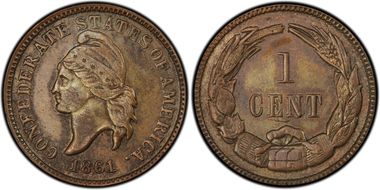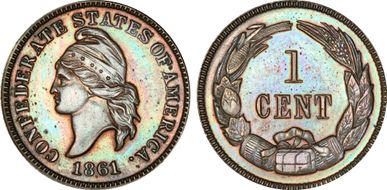- PCGS #:
- 340405
- Designer:
- N/A
- Edge:
- N/A
- Diameter:
- N/A
- Weight:
- N/A
- Mintage:
- N/A
- Mint:
- Philadelphia
- Metal:
- Copper
- Auction Record:
- $52,875 • PR64BN • 05-17-2018 • Legend Rare Coin Auctions
Major Varieties
- 1861 1C CSA Restrike - Copper, BN
- 1861 1C CSA Restrike - Copper, RB
- 1861 1C CSA Restrike - Copper, RD
Go To Grade
Current Auctions - PCGS Graded
Current Auctions - NGC Graded
For Sale Now at Collectors Corner - PCGS Graded
For Sale Now at Collectors Corner - NGC Graded
Condition Census What Is This?
Ron Guth:
Varieties: Restrikes from unbroken dies: Copper - 55 struck Gold - 7 struck Silver - 12 struck Restrikes from broken dies: Aluminum - 50 struck Bronze - 20,000 struck Gold - 3 struck Goldine - 5,000 struck Lead - 50 struck Nickel Silver - 50 struck Platinum - 3 struck Red Fiber - 50 struck Silver - 5,000 struck Tin - 50 struck Zinc - 50 struck
In their June 11, 2001 issue of The Coin Collector, Bowers & Merena Galleries offered an undated (c. 1874) Washington Head/Confederate Cent muling for $24,000.00
P. Scott Rubin:
The Confederate Cent Restike struck in copper is dated 1861 but was produced in 1874 by Philadelphia coin dealer John W. Haseltine and Philadelphia numismatist J. Colvin Randall. Only fifty-five coins were struck in this metal with the same dies used to strike the 1861 Original Confederate Cent, the original was struck in copper-nickel. The dies were acquired from Robert Lovett, Jr., the creator of the coin, either in late 1873 or early 1874.
By the time the restrikes were produced the reverse die used to strike the Confederate Cents had developed a die break on the left side of the die. Because of this die break less force was used to strike the restrikes than was used to strike the originals. By the time these copper restrikes were made copies had been struck in both Gold and Silver. The story told by Haseltine claims that while they were attempting to strike the 56th copper restrike the die broke and no more coins could be made. However, we know that the die was already broken and that when the die was originally given to the Smithsonian by Robert Bashlow in the 1960’s the die was still in one piece, subsequently the die did lose a section of the left side of the reverse because the was badly cracked.
We also know that that sometime after the Haseltine and Randall restrikes were made the dies were defaced with the hope that no more restrikes could be made from these dies. While no more full restikes were ever made from these dies, there are two issues that were produced with the help of the dies. The first is a Washington token that was made in the late 1800’s using an unrelated Washington token die with the now defaced reverse die used to make the Confederate Cent. Then in 1961 Robert Bashlow ( a coin dealer) bought the obverse and reverse dies for the Confederate Cent and had the Philadelphia firm of August Frank make copy dies from the originals so 2nd restrikes of the Confederate Cent could be made and sold to the public. These 2nd restrikes were made in the metals mentioned above by Ron Guth. These were mostly made on double thick planchets and exhibit raised damage that was created when the original dies were defaced.
By the time the restrikes were produced the reverse die used to strike the Confederate Cents had developed a die break on the left side of the die. Because of this die break less force was used to strike the restrikes than was used to strike the originals. By the time these copper restrikes were made copies had been struck in both Gold and Silver. The story told by Haseltine claims that while they were attempting to strike the 56th copper restrike the die broke and no more coins could be made. However, we know that the die was already broken and that when the die was originally given to the Smithsonian by Robert Bashlow in the 1960’s the die was still in one piece, subsequently the die did lose a section of the left side of the reverse because the was badly cracked.
We also know that that sometime after the Haseltine and Randall restrikes were made the dies were defaced with the hope that no more restrikes could be made from these dies. While no more full restikes were ever made from these dies, there are two issues that were produced with the help of the dies. The first is a Washington token that was made in the late 1800’s using an unrelated Washington token die with the now defaced reverse die used to make the Confederate Cent. Then in 1961 Robert Bashlow ( a coin dealer) bought the obverse and reverse dies for the Confederate Cent and had the Philadelphia firm of August Frank make copy dies from the originals so 2nd restrikes of the Confederate Cent could be made and sold to the public. These 2nd restrikes were made in the metals mentioned above by Ron Guth. These were mostly made on double thick planchets and exhibit raised damage that was created when the original dies were defaced.




